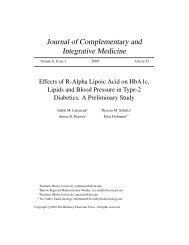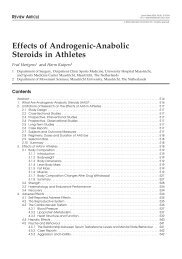Chemistry and Biochemistry of HCA.pdf - AFBoard.com
Chemistry and Biochemistry of HCA.pdf - AFBoard.com
Chemistry and Biochemistry of HCA.pdf - AFBoard.com
Create successful ePaper yourself
Turn your PDF publications into a flip-book with our unique Google optimized e-Paper software.
14 J. Agric. Food Chem., Vol. 50, No. 1, 2002 Reviews<br />
by 88, 70, <strong>and</strong> 60%, respectively, but had no effect on that from<br />
acetoacetate. Lipogenesis from β-hydroxybutyrate involves both<br />
the cytoplasmic <strong>and</strong> citrate pathways. Crabtree et al. (82)<br />
observed that the fluxes <strong>of</strong> butyrate to acetate <strong>and</strong> fatty acids<br />
in rat hepatocytes were inhibited to a similar extent by (-)-<br />
<strong>HCA</strong> with no significant effect on butyrate uptake. Because<br />
butyrate is activated only in the mitochondria <strong>of</strong> rat liver (83)<br />
<strong>and</strong> (-)-<strong>HCA</strong> did not significantly inhibit butyrate uptake, this<br />
parallel inhibition <strong>of</strong> the flux <strong>of</strong> butyrate to acetate <strong>and</strong> fatty<br />
acids strongly suggests that the production <strong>of</strong> acetate occurs in<br />
the cytoplasm. (-)-<strong>HCA</strong> could not be expected to inhibit the<br />
production <strong>of</strong> acetate via the mitochondrial hydrolase. Experiments<br />
with (-)-<strong>HCA</strong> indicate that the major route for conversion<br />
<strong>of</strong> leucine carbon to lipid in rat mammary gl<strong>and</strong> acini is via<br />
citrate translocation from the mitochondria (84). Mathias et al.<br />
(85) reported that in hepatocytes isolated from female rats, mealfed<br />
a high-glucose diet, (-)-<strong>HCA</strong> depressed the incorporation<br />
<strong>of</strong> 3 H 2 O, [ 14 C]alanine, [2- 14 C]leucine into fatty acids <strong>and</strong><br />
cholesterol.<br />
Hood et al. (86) have shown that (-)-<strong>HCA</strong> reduced the<br />
synthesis <strong>of</strong> fatty acids from lactate <strong>and</strong> glucose in bovine<br />
adipose tissue <strong>and</strong> rat adipose tissue, respectively, <strong>and</strong> suggested<br />
that the conversion <strong>of</strong> lactate to fatty acids probably occurs by<br />
way <strong>of</strong> citrate. In the (-)-<strong>HCA</strong>-treated rat liver cells, there was<br />
a decrease in the formation <strong>of</strong> phospholipds <strong>and</strong> triglycerides<br />
from lactate (87). Vicario <strong>and</strong> Medina (88) have also reported<br />
the inhibition <strong>of</strong> lipogenesis from lactate in rat brain by (-)-<br />
<strong>HCA</strong>, <strong>and</strong> the transfer <strong>of</strong> lactate carbons through the mitochondrial<br />
membrane is ac<strong>com</strong>panied by the translocation <strong>of</strong> citrate.<br />
(-)-<strong>HCA</strong> inhibited lipogenesis in rat brain slices (89, 90)<br />
<strong>and</strong> in freshly isolated mouse preputial gl<strong>and</strong> (91). (-)-<strong>HCA</strong><br />
equivalently reduced the biosynthesis <strong>of</strong> triglycerides, phospholipids,<br />
cholesterol, diglycerides, cholesteryl esters, <strong>and</strong> free<br />
fatty acids in isolated liver cells from normal <strong>and</strong> hyperlipidemic<br />
rats (92). (-)-<strong>HCA</strong> decreased the rate <strong>of</strong> cholesterol production<br />
in hepatocytes from fed rats by interfering with the flow <strong>of</strong><br />
substrate into the sterol biosynthetic pathway (93). Measurement<br />
<strong>of</strong> the weight <strong>of</strong> desmosterol produced during its biosynthesis<br />
in the presence <strong>of</strong> tritiated water <strong>and</strong> triparanol has permitted a<br />
direct determination <strong>of</strong> the relative flux <strong>of</strong> carbon <strong>and</strong> tritium<br />
(the H/C ratio) into sterol in hepatocytes. The H/C ratio, which<br />
increased with the time <strong>of</strong> incubation, was shown to decrease<br />
with (-)-<strong>HCA</strong>. The depression <strong>of</strong> biosynthesis <strong>of</strong> long-chain<br />
fatty acids, 3-β-hydroxysterol, <strong>and</strong> cholesterol by (-)-<strong>HCA</strong> was<br />
confirmed in a perfused rat liver system (70, 94, 95). The<br />
inhibition <strong>of</strong> fatty acid synthesis by (-)-<strong>HCA</strong> was associated<br />
with the decreased rate <strong>of</strong> choline incorporation into desaturated<br />
phosphatidylcholine in fetal rat lung (96). Berkhout et al. (97)<br />
tested (-)-<strong>HCA</strong> in Hep G2 cells for effects on cholesterol<br />
homeostasis. After 2.5 <strong>and</strong> 18 h <strong>of</strong> incubation with (-)-<strong>HCA</strong><br />
at a concentration <strong>of</strong> g0.5 mM, incorporation <strong>of</strong> [1,5- 14 C]citrate<br />
into fatty acids <strong>and</strong> cholesterol was strongly inhibited, which<br />
may reflect an effective inhibition <strong>of</strong> ATP:citrate lyase. Preincubation<br />
with a higher concentration <strong>of</strong> (-)-<strong>HCA</strong> increased the<br />
cellular low-density lipoprotein (LDL) receptor activity as<br />
determined by the receptor-mediated association <strong>and</strong> degradation.<br />
Measurements <strong>of</strong> receptor-mediated binding versus LDL<br />
concentration suggested that this increase might be due to an<br />
increase in the number <strong>of</strong> LDL receptors. A simultaneous<br />
increase <strong>of</strong> the enzyme levels <strong>of</strong> 3-hydroxy-3-methylglutaryl-<br />
CoA (HMG) reductase was also observed in the same condition.<br />
These results suggest that the increase in HMG-CoA reductase<br />
<strong>and</strong> LDL receptor are initiated by the decreased flux <strong>of</strong> carbon<br />
units in cholesterol synthetic pathway, owing to inhibition <strong>of</strong><br />
ATP citrate lyase.<br />
Hildebr<strong>and</strong>t et al. (98) studied the utilization <strong>and</strong> preferred<br />
metabolic pathway <strong>of</strong> ketone bodies for the synthesis <strong>of</strong> lipids<br />
by freshly isolated Morris Hepatoma 777 cells, which are known<br />
to actively convert ketone bodies to cholesterol <strong>and</strong> fatty acid.<br />
On the basis <strong>of</strong> the results with (-)-<strong>HCA</strong>, these authors found<br />
that the metabolic pathway for acetoacetate conversion to lipids<br />
is exclusively cytoplasmic, whereas that for 3-hydroxybutyrate<br />
involves both extra- <strong>and</strong> intramitochondrial <strong>com</strong>partments.<br />
Acetyl-L-carnitine is known as a modulator <strong>of</strong> metabolic<br />
function. Lligona-Trulla et al. (99) have studied lipogenesis in<br />
different cell lines <strong>and</strong> in rat hepatocytes <strong>and</strong> observed that the<br />
flux <strong>of</strong> acetyl-L-carnitine (ALC) to lipid was increased, not<br />
decreased, by (-)-<strong>HCA</strong>. In contrast, this inhibitor dramatically<br />
decreased the flux <strong>of</strong> glucose to lipid. These results indicate<br />
that the flux <strong>of</strong> acetyl-L-carnitine to lipid can bypass citrate <strong>and</strong><br />
utilize cytosolic acetyl-CoA synthesis, <strong>and</strong> it was shown that<br />
when (-)-<strong>HCA</strong> was used, the capacity <strong>of</strong> ALC to supply acetyl<br />
units for de novo lipogenesis could be increased significantly.<br />
Because ALC provides acetyl units for metabolic activities<br />
without the cost <strong>of</strong> ATP hydrolysis, this increased capacity may<br />
also represent a mechanism by which ALC can provide acetyl<br />
units in metabolically <strong>com</strong>promised situations. In insulindifferentiated<br />
3T3L1 cells, (-)-<strong>HCA</strong> was shown to inhibit<br />
lipogenesis <strong>and</strong> stimulate lipolysis (100).<br />
Incorporation <strong>of</strong> 3 H from 3 H 2 O was used to measure the rate<br />
<strong>of</strong> fatty acid synthesis in rat liver. In vivo inhibition <strong>of</strong> the rate<br />
<strong>of</strong> fatty acid synthesis in the rat liver was demonstrated after<br />
intraperitoneal/intravenous administration <strong>of</strong> (-)-<strong>HCA</strong> (101).<br />
The in vivo rate <strong>of</strong> lipogenesis was markedly decreased from<br />
[ 14 C]alanine following the administration <strong>of</strong> (-)-<strong>HCA</strong> either<br />
intraperitoneally or intravenously. Fatty acid <strong>and</strong> cholesterol<br />
syntheses were significantly inhibited by the oral administration<br />
<strong>of</strong> (-)-<strong>HCA</strong> only when the <strong>com</strong>pound was given before the<br />
feeding period (65). The oral administration <strong>of</strong> (-)-<strong>HCA</strong> to rats<br />
significantly depressed the in vivo lipogenic rates in a dosedependent<br />
manner in the liver, adipose tissue, <strong>and</strong> small intestine<br />
<strong>and</strong> caused significant reductions in body-weight gain, food<br />
consumption, <strong>and</strong> total body lipid (66, 67). (-)-Hydroxycitric<br />
acid <strong>and</strong> (+)-allo-hydroxycitric acid were also investigated (102)<br />
for their effects on in vivo lipid synthesis under conditions <strong>of</strong><br />
either high-carbohydrate feeding or 24 h fasting, <strong>and</strong> it was<br />
found that in fed rat, (-)-<strong>HCA</strong> significantly reduced the<br />
incorporation <strong>of</strong> labeled H 2 O <strong>and</strong> alanine into fatty acids <strong>and</strong><br />
cholesterol. An increased rate <strong>of</strong> incorporation <strong>of</strong> labeled H 2 O<br />
into fatty acids but no change in cholesterol synthesis in the<br />
fasted rate suggested that (-)-<strong>HCA</strong> might be an activator <strong>of</strong><br />
acetyl-CoA carboxylase. (+)-allo-Hydroxycitric acid was ineffective<br />
in modulating the rates <strong>of</strong> fatty acid synthesis under either<br />
nutritional condition. Both (-)-hydroxycitric acid <strong>and</strong> (+)-allohydroxycitric<br />
acid were shown to be in vitro activators <strong>of</strong> acetyl-<br />
CoA carboxylase, the former being a stronger activator. Thus,<br />
stereospecificity <strong>of</strong> the hydroxycitrate isomers was demonstrated<br />
in both the inhibition <strong>and</strong> stimulation <strong>of</strong> fatty acid synthesis<br />
possibly occurring at the level <strong>of</strong> acetyl-CoA carboxylase.<br />
Because the increase <strong>of</strong> citrate level could have allosterically<br />
activated acetyl-CoA carboxylase (103), this activation <strong>of</strong> acetyl-<br />
CoA carboxylase may be due to the increased level <strong>of</strong> citrate<br />
caused by the inhibition <strong>of</strong> citrate cleavage enzyme with (-)-<br />
<strong>HCA</strong>.<br />
In mature rat, the gold thioglucose-induced obese mouse, <strong>and</strong><br />
the ventromedial hypothalamic lesioned obese rat, food intake,<br />
body-weight gain, <strong>and</strong> depression <strong>of</strong> body lipid levels were




